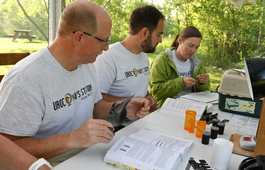
Local efforts are part of a much wider effort assisting with the conservation of birds and their habitats through demographic monitoring. The Monitoring Avian Productivity and Survival Program (MAPS) is a network of stations that capture, band, and re-capture breeding birds at over 1200 locations in North America.

The MAPS station is located at the Red River Valley Natural History Area near the University of Minnesota Crookston (UMN Crookston). Professor John Loegering, Natural Resources Department chair at UMN Crookston, and Lisa Loegering, Northwest Regional director with UMN Extension attend the banding station. Working alongside the Loegerings are Laura Bell, lab services coordinator in natural resources at UMN Crookston and Jeff Bell, a biology instructor at Northland Community and Technical College and adjunct assistant professor at the University of North Dakota. Together, they band birds 7 times during the summer at approximately 10-day intervals.
All MAPS Stations use standardized techniques, protocols, and reporting. Data are compiled and analyzed for hundreds of bird species from across North America. The goal is to better understand reproductive productivity and survival, and the Institute for Bird Populations coordinates this extensive effort.
Using ten very fine mist nets, the Loegerings and Bells capture birds beginning at sunrise and continue for the next six hours. They have been running the station since 2012 and have logged over 1,800 captures including both initial captures and re-captures, of 54 species.

Years of training and apprenticeship are required to open a MAPS banding station and between the Loegerings and Bells, they have more than 72 years of experience banding and handling birds.
Interested students, seasonal student employees, and guests are trained to assist in the process. Natural resources majors Eli Humphrey, a sophomore from Brooklyn Park, Minn., and Kimie Shiozawa, a junior from Tokyo, Japan, assisted with this summer’s operation.
The public is welcome to observe the banding process. Contact John Loegering, jloegeri@umn.edu, for dates and directions.
Background
The Institute for Bird Populations is dedicated to research and dissemination of information on the abundance, distribution, and ecology of birds, and to facilitating scientifically-informed conservation of birds and their habitats. Learn more at www.facebook.com/InstBirdPop/ or www.birdpop.org/pages/maps.php.
About UMN Crookston
One of five campuses that comprise the University of Minnesota System, the University of Minnesota Crookston now delivers 34 bachelor's degree programs and 25 minors on campus as well as 16 degree programs entirely online. These degrees are offered in the areas of agriculture and natural resources; business; liberal arts and education; and math, science and technology. With an enrollment of 1,800 undergraduates from more than 20 countries and 40 states, the Crookston campus offers a supportive, close-knit atmosphere that leads to a prestigious University of Minnesota degree. Visit www.umcrookston.edu.
About UMN
The University of Minnesota System, with campuses in Crookston, Duluth, Morris, Rochester, and the Twin Cities, is driven by a singular vision of excellence. We are proud of our land-grant mission of world-class education, groundbreaking research, and community-engaged outreach, and we are unified in our drive to serve Minnesota.
In photo, right, left to right are John Loegering, Jeff Bell, and Laura Bell.


